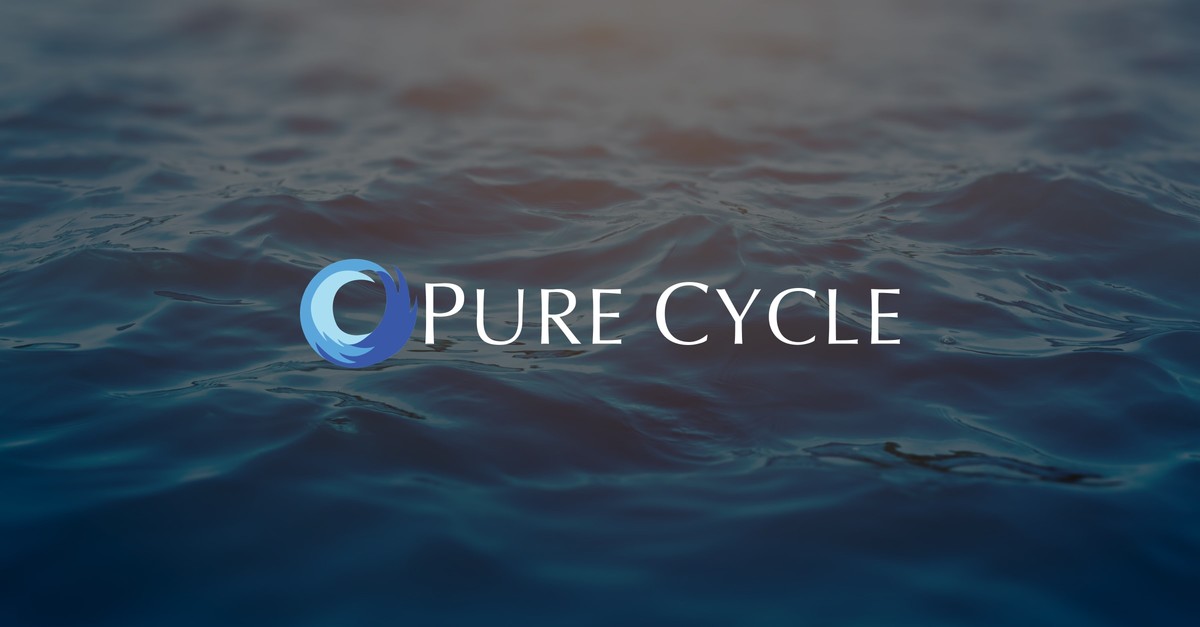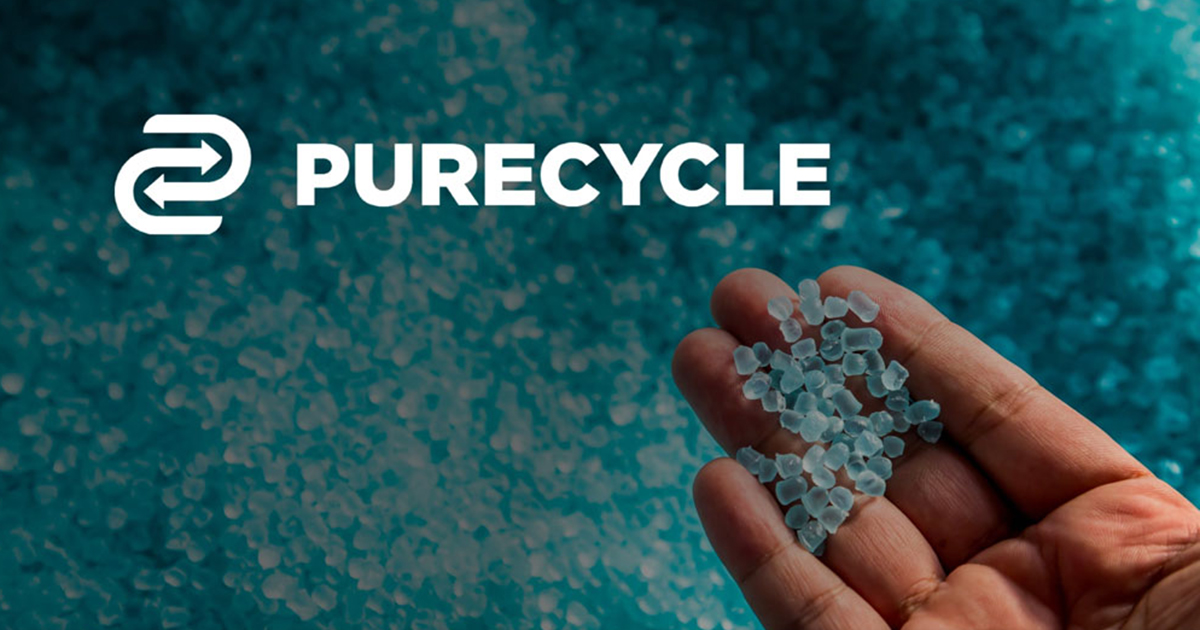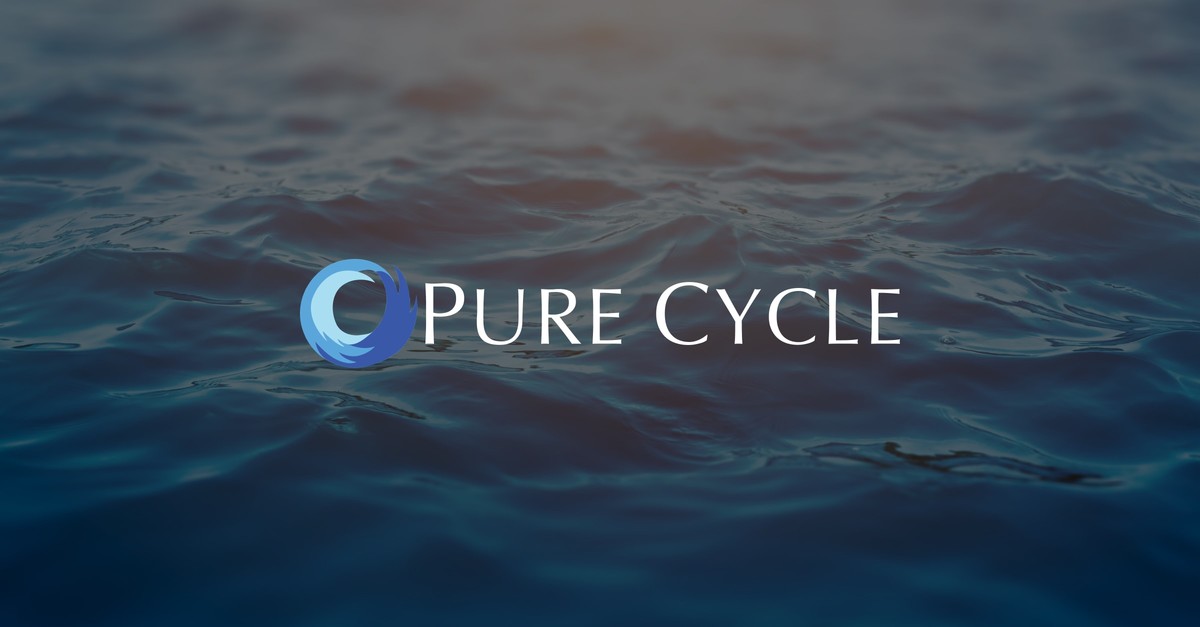Pure Cycle Corporation (PCYO) on Q3 2021 Results - Earnings Call Transcript
Operator: Greetings. Welcome to the Pure Cycle Corporation Third Quarter 2021 Earnings Call. At this time, all participants are in a listen-only mode. Please note, this conference is being recorded. I will now turn the conference over to your host, Mark Harding, President and CEO of Pure Cycle. Thank you. You may begin. Mark Harding: Thank you, Hilary. I would like to welcome you all to our third quarter earnings call. For those of you that have access, you can jump on to our website. And on the landing page, you can join the conference through a live deck -- slide deck that I have that will accompany this presentation. So if you go to purecyclewater.com, and on the landing page, just click that join conference in progress and then that'll allow you to kind of flow along with the presentation. Operator: Thank you, Mark. And our first question is from Bill Miller, Shareholder. Please state your question. Bill Miller: Mark, hi. Mark Harding: Hi, Bill. Bill Miller: Like to hear all the good news, but I'm wondering about 3-year view, and wondering where you're going to get your next land for your apartment rentals or your house rentals, because that seems to be by far the most profitable business you have. And I wonder how big a percentage you're trying to make it and where you're going to get the land for your next at? Mark Harding: That's a great question. We do have, as I've mentioned previously, we do have our nets out for additional land acquisitions, and we have a tremendous amount of land that surrounds us that is available. It's ideally positioned, because I think it's kind of consolidated. You're not dealing with 10-acre assemblages here. We have a lot of land that's around us that would be a half section, a section, or larger assemblages even of that, and really that's kind of where we're looking for our opportunities. We are cognizant that it's a red hot market and expectations are pretty darn high, and we want to make sure that it works for us as well as them. Not to be overly analytic in our acquisitions, you know what we want to try to do is we -- I think we have the ability to pay a little bit more than say anybody else, because we're bringing the water to the table. But in truth a lot of these property owners also know that we're bringing water to the table, and they want a little bit more of the benefit of the water than they actually have. So, we're a little patient on some of that, but we do have some very specific targets in mind. And that's where we're focusing in on that kind of segment. To your other question about the BTRs and kind of the opportunities that that does provide us and the leverage that we create on some equity value there. I will say that the true value of that for the company is really in doing both the land and the utilities, right. There's a lot of companies that are going after this single-family rental market segments, I mean very big companies. If you're talking about the America Home for Rents or BlackRock or any of them, the managed portfolios that are really going after this, they're actually just buying it in the market and really don't have any of that metric margins in there other than being able to capitalize on inexpensive mortgage money. And so, in addition to us being able to do that, we have the equity value that we have on the land and the water. So, that gives us a tremendous value. I don't know that we would actually be out there doing it if we weren't doing the land and the water, but boy that certainly gives us a compelling opportunity. Bill Miller: So, will that be the biggest part of your business in 5 years, that recurring revenue? Mark Harding: We'll wait to see. Certainly, we will have some of that because it's such a large component of the residual recurring revenue that that certainly will be a component of it. I still think that the water utility and the land segment gives us some big compelling projects that have decades worth of growth potential, but I think you're going to like how the BTR model generates a lot of cash flows for us to flex into things like dividends, flex into -- if the market doesn't quite understand what the value of the stock is that we can redeploy some of that revenue that way as well. Bill Miller: Great. I look forward to it. Mark Harding: Thank you. Thanks for your continued support. Operator: Mark, it appears we have no more questions at this time. So, I will now turn the call back over to you for closing remarks. Mark Harding: You bet. You bet. So to the extent that you were not able from a technology standpoint to queue in to ask a question, I do apologize for the brevity of the financial presentation. We do have the metrics out there that kind of give you a quarter-over-quarter results. And then, with the details on each of the segments, you'll see some of that information later. So I'll refresh the presentation. And certainly if you have questions as it leads to some of that detail, don't hesitate to give me a call. I do want to make sure that we have kind of that quarterly analytics that I know a lot of you've got your model set up for, so we can keep that information rolling for you so that you can continue to trend us on that. We do have an Investor Day coming up. So we have a very nice RSVP for the Investor Day. So I welcome all of those of you that are going to be joining us next week to kind of come out and kick the tires. And not only see kind of Phase 1, but kind of -- it gives you real time opportunity to see how some of this horizontal infrastructure sinks in and coordinates in, and it really does give you a feel for the synergies, the synergies of the utilities together with all the horizontals. And then it gives me the ability to highlight where some of these reimbursables come from and how that kind of factors into our overall unit pricing in terms of our lots and then an opportunity to tour our water reclamation facility that we're very proud of, because we're recycling and reusing 100% of our water supply so in addition that us having a very valuable portfolio we use and reuse that portfolio. So, we welcome those of you and if you find yourself traveling through the area and it's not an Investor Day, certainly reach out and give me a holler. I'd love to give you a tour. So with that, I will close that out and look forward to speaking with you all again soon. Operator: This concludes today's conference. You may disconnect your lines at this time. Thank you for your participation and have a great day.
Pure Cycle Corporation's Financial Performance in the Water Services Sector
Pure Cycle Corporation (NASDAQ:PCYO) is a company involved in providing water and wastewater services. It operates primarily in the Denver, Colorado area, focusing on sustainable water solutions. The company competes with other water resource management firms, such as Cadiz Inc. and Global Water Resources, Inc., in delivering efficient water services.
Pure Cycle's Return on Invested Capital (ROIC) is 6.42%, which is lower than its Weighted Average Cost of Capital (WACC) of 9.05%. This results in a ROIC/WACC ratio of 0.71, indicating that the company is not generating returns that exceed its cost of capital. Despite this, Pure Cycle has the highest ROIC/WACC ratio among its peers.
Cadiz Inc. (CDZI) has a negative ROIC of -21.18% and a WACC of 8.70%, leading to a ROIC/WACC ratio of -2.43. This suggests that Cadiz is significantly underperforming in terms of capital efficiency. Similarly, Global Water Resources, Inc. (GWRS) has a ROIC of 1.84% and a WACC of 7.31%, resulting in a ROIC/WACC ratio of 0.25, which is also below optimal levels.
Artesian Resources Corporation (ARTNA) and Parke Bancorp, Inc. (PKBK) have ROIC/WACC ratios of 0.66 and 0.17, respectively. Artesian's ROIC of 3.16% is closer to its WACC of 4.79%, while Parke Bancorp's ROIC of 2.26% is far below its WACC of 13.42%. Peoples Bancorp of North Carolina, Inc. (PEBK) has a ROIC of 1.97% and a WACC of 13.72%, resulting in a ROIC/WACC ratio of 0.14.
Despite Pure Cycle having the highest ROIC/WACC ratio among its peers, all companies in this analysis have ROICs below their respective WACCs. This indicates that none are currently generating returns that exceed their cost of capital, which could be a concern for investors seeking strong capital efficiency.

Pure Cycle Corporation's Financial Performance in the Water Services Sector
Pure Cycle Corporation (NASDAQ:PCYO) is a company involved in providing water and wastewater services. It operates primarily in the Denver, Colorado area, focusing on sustainable water solutions. The company competes with other water resource management firms, such as Cadiz Inc. and Global Water Resources, Inc., in delivering efficient water services.
Pure Cycle's Return on Invested Capital (ROIC) is 6.42%, which is lower than its Weighted Average Cost of Capital (WACC) of 9.05%. This results in a ROIC/WACC ratio of 0.71, indicating that the company is not generating returns that exceed its cost of capital. Despite this, Pure Cycle has the highest ROIC/WACC ratio among its peers.
Cadiz Inc. (CDZI) has a negative ROIC of -21.18% and a WACC of 8.70%, leading to a ROIC/WACC ratio of -2.43. This suggests that Cadiz is significantly underperforming in terms of capital efficiency. Similarly, Global Water Resources, Inc. (GWRS) has a ROIC of 1.84% and a WACC of 7.31%, resulting in a ROIC/WACC ratio of 0.25, which is also below optimal levels.
Artesian Resources Corporation (ARTNA) and Parke Bancorp, Inc. (PKBK) have ROIC/WACC ratios of 0.66 and 0.17, respectively. Artesian's ROIC of 3.16% is closer to its WACC of 4.79%, while Parke Bancorp's ROIC of 2.26% is far below its WACC of 13.42%. Peoples Bancorp of North Carolina, Inc. (PEBK) has a ROIC of 1.97% and a WACC of 13.72%, resulting in a ROIC/WACC ratio of 0.14.
Despite Pure Cycle having the highest ROIC/WACC ratio among its peers, all companies in this analysis have ROICs below their respective WACCs. This indicates that none are currently generating returns that exceed their cost of capital, which could be a concern for investors seeking strong capital efficiency.

Pure Cycle Corporation's Financial Performance and Capital Efficiency
- Pure Cycle Corporation (NASDAQ:PCYO) has a Return on Invested Capital (ROIC) of 6.42% and a Weighted Average Cost of Capital (WACC) of 8.59%, indicating potential capital utilization inefficiencies.
- Comparatively, Artesian Resources Corporation exhibits the highest capital efficiency among peers with a ROIC to WACC ratio of 0.67.
- Most competitors, including Cadiz Inc. and Global Water Resources, Inc., show significant inefficiencies in generating returns on their capital.
Pure Cycle Corporation (NASDAQ:PCYO) is a company involved in the development and management of water and land resources. It operates primarily in the water utility sector, providing water and wastewater services. The company competes with other firms in the industry, such as Cadiz Inc., Artesian Resources Corporation, Global Water Resources, Inc., Parke Bancorp, Inc., and Peoples Bancorp of North Carolina, Inc.
In analyzing Pure Cycle's financial performance, the focus is on its Return on Invested Capital (ROIC) and Weighted Average Cost of Capital (WACC). Pure Cycle's ROIC is 6.42%, while its WACC is 8.59%. This results in a ROIC to WACC ratio of 0.75, indicating that the company is not generating returns that exceed its cost of capital. This suggests potential inefficiencies in how the company utilizes its capital.
Comparatively, Cadiz Inc. has a negative ROIC of -21.18% against a WACC of 8.46%, resulting in a ROIC to WACC ratio of -2.51. This indicates significant inefficiencies and potential financial distress. Artesian Resources Corporation, with a ROIC of 3.16% and a WACC of 4.71%, has a ROIC to WACC ratio of 0.67, the highest among the peers, suggesting relatively better capital efficiency.
Global Water Resources, Inc. has a ROIC of 1.84% and a WACC of 7.26%, leading to a ROIC to WACC ratio of 0.25. This indicates inefficiencies in generating returns on its capital. Parke Bancorp, Inc. and Peoples Bancorp of North Carolina, Inc. have ROIC to WACC ratios of 0.17 and 0.14, respectively, indicating they are not effectively generating returns above their cost of capital.
Overall, while Pure Cycle Corporation is performing better than most of its peers in terms of capital efficiency, it still has room for improvement to exceed its cost of capital. Artesian Resources Corporation stands out with the highest ROIC to WACC ratio, suggesting it is relatively more efficient in its capital utilization compared to the others.

Pure Cycle Corporation's Financial Performance and Capital Efficiency
- Pure Cycle Corporation (NASDAQ:PCYO) has a Return on Invested Capital (ROIC) of 6.42% and a Weighted Average Cost of Capital (WACC) of 8.59%, indicating potential capital utilization inefficiencies.
- Comparatively, Artesian Resources Corporation exhibits the highest capital efficiency among peers with a ROIC to WACC ratio of 0.67.
- Most competitors, including Cadiz Inc. and Global Water Resources, Inc., show significant inefficiencies in generating returns on their capital.
Pure Cycle Corporation (NASDAQ:PCYO) is a company involved in the development and management of water and land resources. It operates primarily in the water utility sector, providing water and wastewater services. The company competes with other firms in the industry, such as Cadiz Inc., Artesian Resources Corporation, Global Water Resources, Inc., Parke Bancorp, Inc., and Peoples Bancorp of North Carolina, Inc.
In analyzing Pure Cycle's financial performance, the focus is on its Return on Invested Capital (ROIC) and Weighted Average Cost of Capital (WACC). Pure Cycle's ROIC is 6.42%, while its WACC is 8.59%. This results in a ROIC to WACC ratio of 0.75, indicating that the company is not generating returns that exceed its cost of capital. This suggests potential inefficiencies in how the company utilizes its capital.
Comparatively, Cadiz Inc. has a negative ROIC of -21.18% against a WACC of 8.46%, resulting in a ROIC to WACC ratio of -2.51. This indicates significant inefficiencies and potential financial distress. Artesian Resources Corporation, with a ROIC of 3.16% and a WACC of 4.71%, has a ROIC to WACC ratio of 0.67, the highest among the peers, suggesting relatively better capital efficiency.
Global Water Resources, Inc. has a ROIC of 1.84% and a WACC of 7.26%, leading to a ROIC to WACC ratio of 0.25. This indicates inefficiencies in generating returns on its capital. Parke Bancorp, Inc. and Peoples Bancorp of North Carolina, Inc. have ROIC to WACC ratios of 0.17 and 0.14, respectively, indicating they are not effectively generating returns above their cost of capital.
Overall, while Pure Cycle Corporation is performing better than most of its peers in terms of capital efficiency, it still has room for improvement to exceed its cost of capital. Artesian Resources Corporation stands out with the highest ROIC to WACC ratio, suggesting it is relatively more efficient in its capital utilization compared to the others.

Pure Cycle Corporation's Financial Performance in Comparison
Pure Cycle Corporation (NASDAQ:PCYO) is a company involved in water and land resource development. It focuses on providing water and wastewater services, as well as land development. In the competitive landscape, Pure Cycle is compared with companies like Cadiz Inc., Artesian Resources Corporation, Global Water Resources, Inc., Parke Bancorp, Inc., and Peoples Bancorp of North Carolina, Inc. These companies operate in similar sectors, providing a basis for financial performance comparison.
Pure Cycle's ROIC of 6.42% is lower than its WACC of 8.61%, resulting in a ROIC to WACC ratio of 0.75. This indicates that Pure Cycle is not generating returns that exceed its cost of capital. Despite this, it performs better than most of its peers in terms of this metric. For instance, Cadiz Inc. has a negative ROIC of -21.18%, which is significantly below its WACC of 8.47%, leading to a ROIC to WACC ratio of -2.50.
Artesian Resources Corporation, with a ROIC of 3.16% and a WACC of 4.73%, has the highest ROIC to WACC ratio among the peers at 0.67. This suggests that while Artesian's returns do not exceed its cost of capital, it is relatively more efficient compared to others. Global Water Resources, Inc. and Parke Bancorp, Inc. also have ROICs lower than their WACCs, with ratios of 0.25 and 0.17, respectively, indicating inefficiency in generating returns over their cost of capital.
Peoples Bancorp of North Carolina, Inc. has the lowest ROIC to WACC ratio of 0.14 among the peers, with a ROIC of 1.97% and a WACC of 13.96%. This highlights its inefficiency in generating returns over its cost of capital. Despite Pure Cycle's ROIC to WACC ratio of 0.75 being higher than most peers, it still falls short of generating returns above its cost of capital, indicating room for improvement in its financial performance.

Pure Cycle Corporation's Financial Performance in Comparison
Pure Cycle Corporation (NASDAQ:PCYO) is a company involved in water and land resource development. It focuses on providing water and wastewater services, as well as land development. In the competitive landscape, Pure Cycle is compared with companies like Cadiz Inc., Artesian Resources Corporation, Global Water Resources, Inc., Parke Bancorp, Inc., and Peoples Bancorp of North Carolina, Inc. These companies operate in similar sectors, providing a basis for financial performance comparison.
Pure Cycle's ROIC of 6.42% is lower than its WACC of 8.61%, resulting in a ROIC to WACC ratio of 0.75. This indicates that Pure Cycle is not generating returns that exceed its cost of capital. Despite this, it performs better than most of its peers in terms of this metric. For instance, Cadiz Inc. has a negative ROIC of -21.18%, which is significantly below its WACC of 8.47%, leading to a ROIC to WACC ratio of -2.50.
Artesian Resources Corporation, with a ROIC of 3.16% and a WACC of 4.73%, has the highest ROIC to WACC ratio among the peers at 0.67. This suggests that while Artesian's returns do not exceed its cost of capital, it is relatively more efficient compared to others. Global Water Resources, Inc. and Parke Bancorp, Inc. also have ROICs lower than their WACCs, with ratios of 0.25 and 0.17, respectively, indicating inefficiency in generating returns over their cost of capital.
Peoples Bancorp of North Carolina, Inc. has the lowest ROIC to WACC ratio of 0.14 among the peers, with a ROIC of 1.97% and a WACC of 13.96%. This highlights its inefficiency in generating returns over its cost of capital. Despite Pure Cycle's ROIC to WACC ratio of 0.75 being higher than most peers, it still falls short of generating returns above its cost of capital, indicating room for improvement in its financial performance.

Pure Cycle Corporation's Financial Performance and Competitive Landscape
- Pure Cycle Corporation (NASDAQ:PCYO) has a Return on Invested Capital (ROIC) of 6.42%, which is lower than its Weighted Average Cost of Capital (WACC) of 8.68%, indicating inefficiencies in capital utilization.
- Despite its challenges, Pure Cycle has the highest ROIC to WACC ratio of 0.74 among its peers, leading the group in capital efficiency.
- Competitors like Cadiz Inc., Artesian Resources Corporation, and others show varying degrees of financial distress and inefficiency, with Pure Cycle Corporation emerging as a relative leader in ROIC to WACC ratio.
Pure Cycle Corporation (NASDAQ:PCYO) is a company involved in water and land resource development. It focuses on providing water and wastewater services, as well as land development. The company operates primarily in Colorado, where it manages water rights and infrastructure. In the competitive landscape, Pure Cycle's peers include companies like Cadiz Inc., Artesian Resources Corporation, Global Water Resources, Inc., Parke Bancorp, Inc., and Peoples Bancorp of North Carolina, Inc.
In analyzing Pure Cycle's financial performance, the Return on Invested Capital (ROIC) is a key metric. Pure Cycle's ROIC stands at 6.42%, which is lower than its Weighted Average Cost of Capital (WACC) of 8.68%. This indicates that the company is not generating returns that exceed its cost of capital, suggesting inefficiencies in capital utilization. Despite this, Pure Cycle has the highest ROIC to WACC ratio of 0.74 among its peers.
Cadiz Inc. presents a stark contrast with a negative ROIC of -21.18% and a WACC of 8.54%. This results in a ROIC to WACC ratio of -2.48, highlighting significant financial distress and poor capital efficiency. Artesian Resources Corporation, with a ROIC of 3.16% and a WACC of 4.77%, also shows inefficiencies, but its ROIC to WACC ratio of 0.66 is closer to Pure Cycle's.
Global Water Resources, Inc. and Parke Bancorp, Inc. both exhibit ROIC figures lower than their respective WACC, with ratios of 0.25 and 0.17, respectively. This indicates that these companies are also struggling to generate returns above their cost of capital. Peoples Bancorp of North Carolina, Inc. has the lowest ROIC to WACC ratio of 0.14, further emphasizing inefficiencies in capital utilization.
Overall, while Pure Cycle Corporation leads its peer group in terms of ROIC to WACC ratio, all companies in this analysis face challenges in generating returns that exceed their cost of capital. This highlights potential areas for improvement in capital efficiency across the board.







